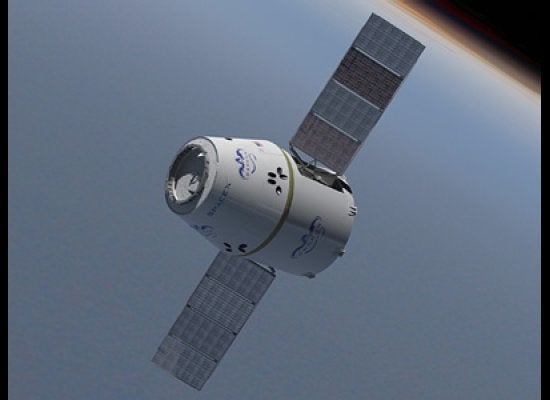A private company's prototype reusable rocket made its highest leap to date last month, soaring 100 stories into the air before landing softly back at its launch pad as planned.
In its sixth-ever test flight, SpaceX's experimental Grasshopper rocket hopped to a maximum altitude of 1,066 feet (325 meters) on June 14. It then made a slow and controlled descent back to Earth at the company's rocket development facility in McGregor, Texas.
SpaceX released a 95-second video of Grasshopper's latest amazing flight on Friday (July 5), showing the action from above as seen by a small robotic "hexacopter" drone.
Most rockets are designed to be expendable, burning up in Earth's atmosphere after delivering their payloads to space. SpaceX wants to develop fully reusable launch vehicles, which experts say would make spaceflight much cheaper and more efficient.
The 10-story-tall Grasshopper is a big step in this direction, company officials say. The rocket takes off and lands vertically, touching down on four metallic legs back at its launch pad.
Grasshopper incorporates the first-stage tank of SpaceX's Falcon 9 rocket, which launches the California-based firm's Dragon capsule on unmanned cargo missions to the International Space Station for NASA. But Grasshopper uses just one Merlin engine while the Falcon 9 sports nine (as its name suggests).
SpaceX's Grasshopper has been leaping higher and higher with every successive test flight. Its previous launches took place in September, November and December of 2012, and March and April of this year. Those hops reached peak altitudes of 8.2 feet (2.5 m), 17.7 feet (5.4 m), 131 feet (40 m), 263 feet (80 m) and 820 feet (250 m), respectively.
In addition to reaching unprecedented heights, the most recent flight also incorporated new navigation technology, company officials said.
"For the first time in this test, Grasshopper made use of its full navigation sensor suite with the F9-R closed loop control flight algorithms to accomplish a precision landing," SpaceX officials wrote in a description accompanying the flight video. "Most rockets are equipped with sensors to determine position, but these sensors are generally not accurate enough to accomplish the type of precision landing necessary with Grasshopper."
Follow Mike Wall on Twitter @michaeldwall and Google+. Follow us @Spacedotcom, Facebook or Google+. Originally published on SPACE.com.
Copyright 2013 SPACE.com, a TechMediaNetwork company. All rights reserved. This material may not be published, broadcast, rewritten or redistributed.
Support HuffPost
Our 2024 Coverage Needs You
Your Loyalty Means The World To Us
At HuffPost, we believe that everyone needs high-quality journalism, but we understand that not everyone can afford to pay for expensive news subscriptions. That is why we are committed to providing deeply reported, carefully fact-checked news that is freely accessible to everyone.
Whether you come to HuffPost for updates on the 2024 presidential race, hard-hitting investigations into critical issues facing our country today, or trending stories that make you laugh, we appreciate you. The truth is, news costs money to produce, and we are proud that we have never put our stories behind an expensive paywall.
Would you join us to help keep our stories free for all? Your contribution of as little as $2 will go a long way.
Can't afford to donate? Support HuffPost by creating a free account and log in while you read.
As Americans head to the polls in 2024, the very future of our country is at stake. At HuffPost, we believe that a free press is critical to creating well-informed voters. That's why our journalism is free for everyone, even though other newsrooms retreat behind expensive paywalls.
Our journalists will continue to cover the twists and turns during this historic presidential election. With your help, we'll bring you hard-hitting investigations, well-researched analysis and timely takes you can't find elsewhere. Reporting in this current political climate is a responsibility we do not take lightly, and we thank you for your support.
Contribute as little as $2 to keep our news free for all.
Can't afford to donate? Support HuffPost by creating a free account and log in while you read.
Dear HuffPost Reader
Thank you for your past contribution to HuffPost. We are sincerely grateful for readers like you who help us ensure that we can keep our journalism free for everyone.
The stakes are high this year, and our 2024 coverage could use continued support. Would you consider becoming a regular HuffPost contributor?
Dear HuffPost Reader
Thank you for your past contribution to HuffPost. We are sincerely grateful for readers like you who help us ensure that we can keep our journalism free for everyone.
The stakes are high this year, and our 2024 coverage could use continued support. If circumstances have changed since you last contributed, we hope you’ll consider contributing to HuffPost once more.
Already contributed? Log in to hide these messages.
